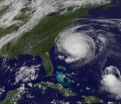Sight-saving research halted by stem cell ruling
ARVO opposes the Federal District Court injunction that froze federal funding for human embryonic stem cell (hESC) research
2010-09-04
(Press-News.org) The Association for Research in Vision and Ophthalmology (ARVO), a professional organization of member scientists, opposes the Federal District Court injunction that froze federal funding for human embryonic stem cell (hESC) research. ARVO is troubled by this barrier to research that has the potential to restore sight and mitigate eye damage.
ARVO members investigate hESC therapies for treating diseases such as age-related macular degeneration (AMD), diabetic retinopathy, glaucoma and corneal disease, along with studies related to eye tissue transplantation, regeneration and engineering. ARVO's policy supports technological developments and policies that encourage all facets of stem cell research, including research utilizing hESCs.
"A generation of researchers may turn away from pluripotent stem cell research in general as a result of this ruling," says one ARVO member. This researcher uses stem cell lines that were in use for many years prior to President Obama's Executive Order and were approved for use earlier this year under retroactive 2009 guidelines governing the use of hESCs. But because of the District Court injunction, a key grant for research on human retinal development has been stopped. He adds: "Left to those who continue to claim that adult stem cells hold all the same properties as pluripotent stem cells (a vocal minority), the stem cell field could regress substantially. In addition, promising research in other areas related to embryonic stem cell research may never reach its full potential."
A scientist working on translational AMD studies stated, "This ruling will disrupt or halt important stem cell research programs, and it represents a major setback to the hopes of hundreds of thousands of patients who stand to benefit from the outcomes of this work . . . These pioneering trials will require much additional research to refine stem cell therapies and to improve their safety and efficacy before they can become routinely available to patients on a large scale. It is critical that the National Institutes of Health (NIH) support the basic and translational studies that are essential to achieve this goal and to move the field forward. The decision will not only impact ongoing studies, but will also send a very negative message to scientists and physicians, particularly young researchers, who have dedicated their careers to pursue this promising new area of science. We can only hope that the ruling will be reversed promptly."
Much progress in vision science with hESCs is occurring outside the United States. ARVO members work under liberal stem cell policies in Australia, Belgium, China, India, Israel, Japan, South Korea, Sweden and the United Kingdom. Vision scientists in the United Kingdom aim to have a hESC therapy for AMD available for clinic use by 2011.
ARVO members working under restrictive stem cell policies include those in the United States, Austria, Germany, Ireland, Italy, Norway and Poland. Barred from federal funding, United States researchers expect to use private funds for a hESC trial for juvenile macular degeneration (Stargardt's disease). However, there simply is not enough private funding to cover all embryonic stem cell research. An irreparable loss to biomedical research will result from NIH being forced to stop peer review of 50 grants, halt final review of 12 grants worth $15-20 million and stop renewal of 22 grants worth $54 million. Overall, this puts the United States further behind the curve in solving major health problems that could bring relief to millions of suffering patients and their families.
Judge Lamberth claimed his ruling "would not seriously harm hESC researchers because the injunction would simply preserve the status quo and would not interfere with their ability to obtain private funding for their research." This prediction may be internally consistent with his legal ruling, but affected researchers have found that, contrary to the judge's expectation, the ruling immediately disrupted research. As one vision scientist put it, extramural scientists overnight were forced to separate any infrastructure, equipment, consumables or personnel funded by Federal agencies from those funded by private sources, completely obstructing all research activities. Worse, all intramural hESC projects at NIH have been terminated. As ARVO Board members have emphasized, "Restarting these research programs after political issues are resolved will be extremely difficult, and in some cases, likely will be impossible. Human embryonic stem cells are being maintained in cultures in labs around the world. Precious cell cultures at NIH and elsewhere could be lost if ongoing work is halted until political decisions are resolved."
ARVO stands behind the statement made by NIH Director Francis Collins, MD, PhD, "The injunction threatens to stop progress in one of the most encouraging areas of biomedical research, just as scientists are gaining momentum — and squander the investment we have already made. The possibility of using these cells to replace those that have been damaged by disease or injury is one of the most breathtaking advances we can envision. Human embryonic stem cells also represent a powerful new approach to the early stages of screening for new drugs, and may hold the secrets to creating entirely new, targeted clinical therapies. We must move forward — without delay — to sustain this field of research that provides so much hope for thousands of patients and their families."
###
About ARVO
ARVO is the world's largest international association of eye and vision scientists. Our members include more than 12,600 scientists from over 80 countries. ARVO encourages and assists research, training, publication and knowledge-sharing in vision and ophthalmology.
www.arvo.org
END
ELSE PRESS RELEASES FROM THIS DATE:
2010-09-04
LA JOLLA, CA – September 2, 2010 – Scripps Research Institute scientists have identified two proteins with potential to be important targets for research into a wide range of health problems, including pain, deafness, and cardiac and kidney dysfunction.
The study was published in Science Express, the advanced, online edition of the journal Science, on September 2, 2010.
In the study, the Scripps Research scientists identify two proteins, which they named Piezo1 and Piezo2 from the Greek meaning "pressure," involved in the cellular response to mechanical stimulation. ...
2010-09-04
Studies have shown that heat-stressed dairy cows suffer from damage to their ovarian follicles. Moreover, the eggs produced by the damaged follicles may also be damaged, said Dr. Todd Bilby, Texas AgriLife Extension Service dairy specialist.
Worse, after becoming heat-stressed, other studies have shown the eggs she ovulates for the next 40 or 50 days are likely to be damaged as well, according to Bilby.
Bilby and his graduate student, Brandi Stewart, have found a way to double pregnancy rates during the summer and increase the number of heifers born as compared with ...
2010-09-04
PASADENA, Calif.—Researchers at the California Institute of Technology (Caltech) have devised a new technique—using a sheet of carbon just one atom thick—to visualize the structure of molecules. The technique, which was used to obtain the first direct images of how water coats surfaces at room temperature, can also be used to image a potentially unlimited number of other molecules, including antibodies and other biomolecules.
A paper describing the method and the studies of water layers appears in the September 3 issue of the journal Science.
"Almost all surfaces have ...
2010-09-04
New Orleans, LA – In a first person paper published in the August 27, 2010 issue of Childhood Obesity, Dr. Melinda Sothern, Director of Health Promotion and Professor of Public Health at LSU Health Sciences Center New Orleans, provides three ways to de-program the 1950s obesity trinity underlying the current obesity epidemic in the United States and protect future generations from its health consequences.
"The combination of prenatal tobacco use, infant formula, and frequent pregnancies—
i.e., the obesity trinity—synergistically created the first generation of nutritionally ...
2010-09-04
UCSF researchers today unveiled a prototype model of the first implantable artificial kidney, in a development that one day could eliminate the need for dialysis.
The device, which would include thousands of microscopic filters as well as a bioreactor to mimic the metabolic and water-balancing roles of a real kidney, is being developed in a collaborative effort by engineers, biologists and physicians nationwide, led by Shuvo Roy, PhD, in the UCSF Department of Bioengineering and Therapeutic Sciences.
The treatment has been proven to work for the sickest patients using ...
2010-09-04
Hurricane Earl is still a powerful category four hurricane on the Saffir-Simpson Scale as it approaches the North Carolina coast today. NASA's Tropical Rainfall Measuring Mission (TRMM) satellite observed the high rates rain was falling within Earl, in some areas more than 2 inches per hour. Today, the Global Hawk unmanned aircraft is also flying into the eye of Hurricane Earl at altitudes of 60,000 feet to gather information about the storm.
Hurricane Earl became the most powerful hurricane of the 2010 Atlantic season early on September 2 when its sustained winds reached ...
2010-09-04
ANN ARBOR, Mich.---Protecting helicopters in combat from heat-seeking missiles is the goal of new laser technology created at the University of Michigan and Omni Sciences, Inc., which is a U-M spin-off company.
"Battlefield terrain in places like Afghanistan and Iraq can be so rough that our troops have often had to rely on helicopters, and they can be easy targets for enemies with shoulder-launched missiles," said Mohammed Islam, a professor in the Department of Electrical Engineering and Computer Science.
"Our lasers give off a signal that's like throwing sand in ...
2010-09-04
Bermuda has warnings up as Tropical Storm Fiona approaches, and GOES-13 satellite imagery from today shows that Fiona, although packing a punch, is a much smaller system that her brother, the Category 4 Hurricane Earl.
A tropical storm warning is in effect for Bermuda today, Sept. 2, as tropical storm force winds are expected there by late Friday. Bermuda can expect between 1 to 3 inches of rainfall from Fiona.
When the Geostationary Operational Environmental Satellite called GOES-13 captured a visible image of Tropical Storm Fiona approaching Bermuda this afternoon ...
2010-09-04
BIRMINGHAM, Ala. – Cigarette smoke shuts off a key enzyme in airways that regulates the body's response to inflammation, according to findings from the University of Alabama at Birmingham published online today at Science Express.
The UAB researchers say smoke inhibits the enzyme, called Leukotriene A4 Hydrolase (LTA4H), causing it to fail in its job of shutting down white blood cells following a successful response to inflammation.
The team says the research study identified a previously unknown substrate of LTA4H called proline-glycine-proline (PGP). In a normal ...
2010-09-04
COLUMBUS, Ohio – There is yet no straightforward way to determine the optimal dose level and treatment schedules for high-dose radiation therapies such as stereotactic radiation therapy, used to treat brain and lung cancer, or for high-dose brachytherapy for prostate and other cancers.
Radiation oncologists at the Ohio State University Comprehensive Cancer Center-Arthur G. James Cancer Hospital and Richard J. Solove Research Institute (OSUCCC-James) may have solved the problem by developing a new mathematical model that encompasses all dose levels.
Typically, radiation ...
LAST 30 PRESS RELEASES:
[Press-News.org] Sight-saving research halted by stem cell ruling
ARVO opposes the Federal District Court injunction that froze federal funding for human embryonic stem cell (hESC) research


